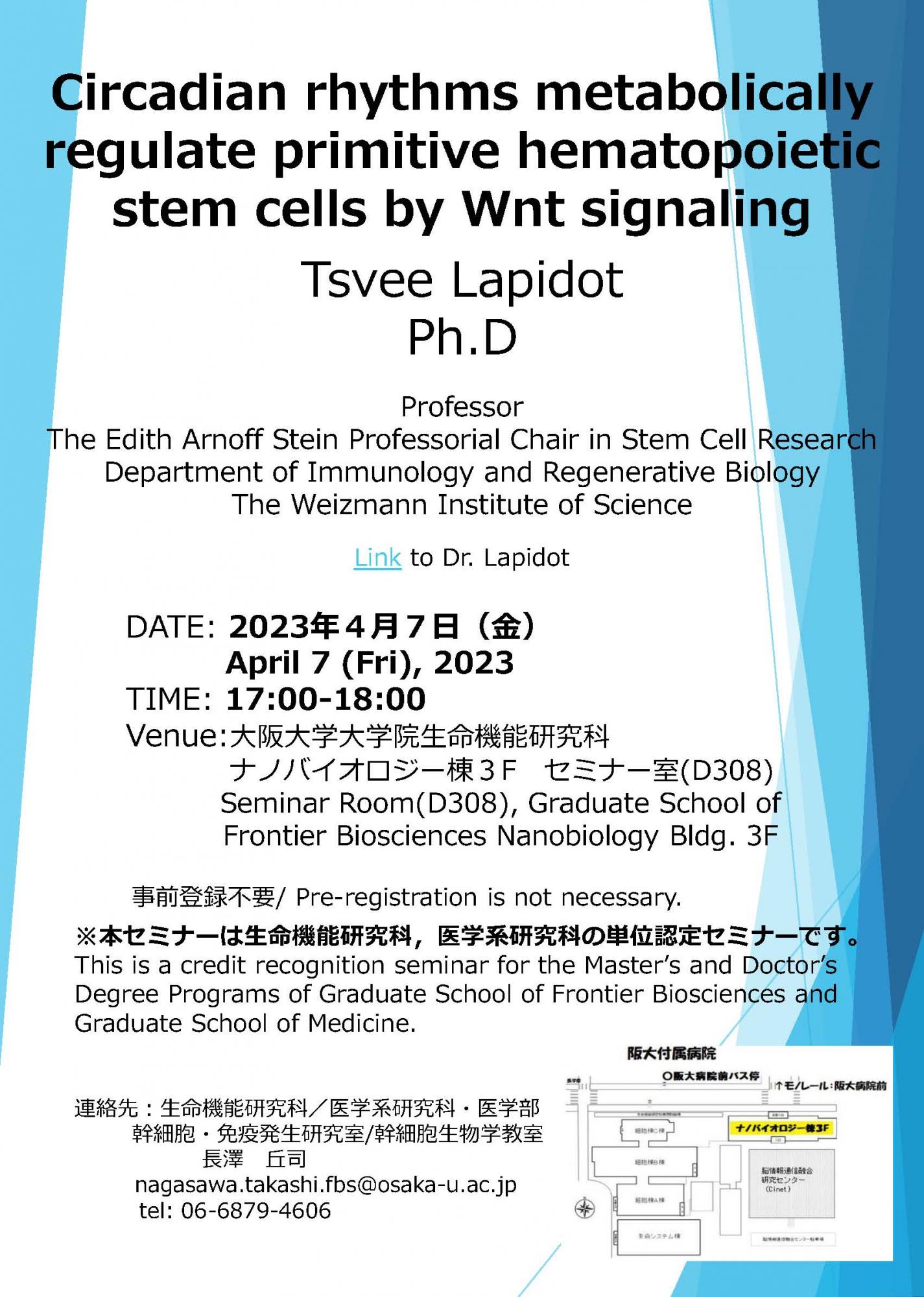Research seminars Circadian rhythms metabolically regulate primitive hematopoietic stem cells by Wnt signaling
| Seminar or Lecture |
Circadian rhythms metabolically regulate primitive hematopoietic stem cells by Wnt signaling Tsvee Lapidot Ph.D. [Professor, The Edith Arnoff Stein Professorial Chair in Stem Cell Research, Department of Immunology and Regenerative Biology, The Weizmann Institute of Science] |
|---|---|
| Date and Time | 7 Apr. 2023 (Fri), 17:00-18:00 |
| Place | Seminar Room(D308), Graduate School of Frontier Biosciences Nanobiology Bldg. 3F |
| Language | English |
| Contact |
Takashi Nagasawa (Professor) |
Circadian rhythms metabolically regulate primitive hematopoietic stem cells by Wnt signaling
Primitive Hematopoietic stem cells (pHSP) are mostly retained in the mouse bone marrow (BM) in a low metabolic, non-motile and quiescent state. Previously, others and we reported that circadian cues regulate hematopoietic stem and progenitor cells (HSPC) fate decisions. Daily light cues induce a fraction of BM HSPCs to proliferate, differentiate and egress from the BM to the blood, in order to replenish the circulation with mature blood and immune cells with a finite life span. While darkness cues metabolically reprogram HSPC in order to elevate their self-renewal to maintain the BM reservoir of immature and undifferentiated HSPC. We also reported higher BM retained competitive pHSC repopulation potential at night darkness compared to daylight morning. The dynamic switch between HSC quiescence and metabolic activation involves transient light onset mediated increase in their ROS levels and darkness onset mediated increase in BM melatonin and PGE-2. Currently we aim to study how the intrinsic cell signaling pathways dictate metabolic changes among pHSCs under circadian rhythms and to elucidate the mechanisms behind these changes.
We have applied single stem cell RNA sequencing, flow cytometric and immunofluorescence analysis with functional HSPC competitive repopulation potential quantification assays in wild type and knockout mice models in order to study the mechanisms behind the metabolic changes among HSPCs and primitive HSCs.
Preliminary results obtained by our HSC pathway enrichment analysis marked Wnt signaling to be significantly upregulated at night. We further found that the downstream transcription factor of Wnt signaling, TCF7L2 to regulate the expression of the Glut1 gene (SLC2a1) among HSCs including human. Darkness cues were further found to be associated with enhanced hypoxia, Hif1a gene expression and enhanced transcriptional expression of glycolytic pathway genes in HSPC. Importantly, we found both increased expression of the glucose transporter, Glut1 in BM retained HSPC and higher glucose uptake at night only in primitive EPCR+ HSCs, pointing to Glut1 as a metabolic marker of primitive HSCs under circadian regulation. These metabolic changes are accompanied with lower HSPC mitochondrial membrane potential, and higher mitochondrial ROS and calcium levels at night. Moreover, we observed an increase in expression of mitophagy-related genes expression at night.
In summary, our results suggest that Wnt signaling is metabolically regulated by circadian light and darkness cues in primitive HSCs. This pathway promotes enhanced glycolysis with higher Glut1 expression in primitive HSCs at night. This further reduces the dependance of primitive HSCs on mitochondrial ATP generation, suggesting mitochondrial fission occurring more at night and fusion during daylight. Therefore, a dynamic balance exists between metabolic regulation and mitochondrial dynamics in BM retained primitive HSC function under light and darkness control in order to renew their mitochondria arsenal and to be ready on demand during alarm situations.
This is a credit recognition seminar for the Master’s and Doctor’s Degree Programs of Graduate School of Frontier Biosciences.

